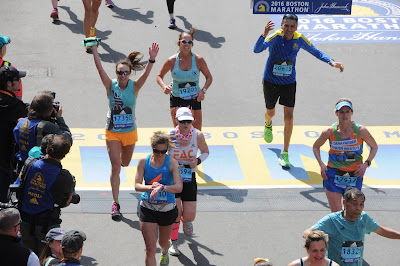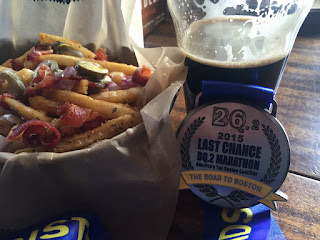Little did I know when I began training for my very first marathon last spring, that I would be setting myself up for a major marathon spring. A Boston Qualifying (BQ) had been my goal, and I nailed it with enough time to spare to land a coveted bib at the 2016 Boston Marathon. One would think running Boston would be enough of a challenge for the spring...who is crazy enough to contemplate running three spring marathons in a row?
Me. And my boyfriend, Steve.
 |
| Crossing the 2016 Boston Marathon finish line. |
 |
| Claiming my finisher's medal. |
Shortly after I picked up my Boston training, registration for the 2016 TCTC Bayshore Marathon in Traverse City opened. This is a beautiful course, as I discovered when I ran the Bayshore Half Marathon in 2014, and a Boston Qualifier. Always the planner, I thought it could be fun to do another spring marathon after Boston. After all, I’d already have the miles and work in for Boston...what would a few more weeks of training be after a quick recovery from Boston? And, to top it all off...lets offer to pace another Northern Michigan marathon just four weeks after Bayshore? It would be a great training run for the 50K ultramarathon on the calendar for July. How hard could this possibly be?
Hard. So very hard. Boston was quite possibly the hardest race I’ve ever done. Unless you’ve run the course, I don’t think it is possible to truly be prepared for what it has in store. Compound that with the blistering heat and 100% sunny skies that April 18th offered up for race weather, and I was happy just to finish. (Listen to my 2016 Boston Marathon Recap with Michigan Runner Girl here.) Boston shook my confidence in my ability to run marathon distances badly. I questioned my training. I questioned my paces that I ran throughout my 16 weeks of training. Recovery was longer than I anticipated and I felt the pressure to jump back into training to maintain whatever endurance I had for Bayshore, which was my goal race.
Simultaneously Training While Recovering
After Boston, I was left seriously reconsidering any desire to run another marathon. My gut reaction was “hell no!” but then that also meant ultra running was out for me. I didn’t want to give up on that dream, so I gave myself a bit of time to lapse into marathon amnesia. It took a good two weeks of gentle running with minimal mileage before my legs felt snappy again and my training paces didn’t feel they took extensive effort. I felt pressure from myself to get back into training so that I had a shot at a new PR at Bayshore. But rushing the recovery process wasn’t going to help me perform any better. I had six weeks to both recover and train/maintain.
 |
| Flat Courtney |
Leading up to Bayshore, I listened to my body a bit more. My boyfriend Steve and I recreated the last three weeks of our Boston training plan with a few minor adjustments. (We use the Hanson Method but used Jack Daniel’s training paces.) We knew quality workouts were key but the long, slower miles were also critical. We also threw in a race/tempo training run two weeks prior to the marathon.
 |
| Pre-Race...already warm & muggy |
Racing Proactively
During my taper for Bayshore, I took my runs as easy as I possibly could, allowing myself the grace of a few extra rest days rather than stress about missing a run. The forecast for Bayshore was looking ominous: humid, scattered thunderstorms, warm. I did not want another experience like Boston. Reeling in the impulses to check the weather every hour in the days leading up to marathon number three, I focused on what I could control: my race strategy and how I could combat the heat and humidity.
Negative splits and a new PR were my goals on race day. I would go out conservatively, aiming for 7:50/mi pace and hold back until I got past the turnaround. Then I would reevaluate how I was feeling and try to drop my pace down to 7:45/mi. At Mile 20, I would throw in whatever I had left. I promised myself I would stick to my plan; going out any faster would spell disaster and my primary goal was to do ‘better than Boston.
I also searched for ways to keep my core temperature as cool as possible for as long as possible. We were camping, so access to a freezer for my water bottle was out of the question. But I used ice and the coldest water I could find to use in my water bottle to start.
A dollar store sponge was my only wild card on race day I stuck the sponge down the back of my Oiselle singlet, with just a bit poking up for easy access. My crazy idea was to pour water on it in order to cool down my neck, therefore my body. I also held off on this method of cooling as long as I could, waiting until about mile 10 to begin double fisting it at water stations in order to pour water on my sponge. This truly was a lifesaver! It was easy enough to grab it and wring water out of it before the next aid station to ready it for another dousing of cold water. My only issue was that by mile 20, my feet were squishy from the water that had trickled down into my shoes.. Still totally worth it. I only suffered a minor blister on one toe.
Mentally Maintaining
Having run the half marathon at Bayshore a few years ago, I knew that I would be crossing the half marathoners coming down the Old Mission Peninsula as I was heading up it. Several friends were running the half marathon, so searching for friendly faces and my Oiselle teammates kept from focusing too much inwardly. This was the most relaxed I have ever felt running a race...I didn’t feel the pressure I felt at Boston to ‘perform’ well...to race and achieve a very specific time goal. That gave me the mental freedom to relax and truly enjoy the breathtaking course.
 |
| GHRC Marathoners ready for the start. |
Hitting the Goal, Not the Wall
I am so incredibly proud of myself for sticking with my race plan and executing it, holding myself pace to a reasonable pace. Usually, I go out too fast and burn out/hit the wall. (At Boston, I fell face first into the wall and did so very early on into the race.) While I don’t think I achieved an actual negative split, my pace was very consistent and steady overall. I didn’t feel the need to slow down at all until Mile 23, taking the briefest of walk breaks, more for mental regrouping than anything. Steve was by my side from mile 14 to the very end, crossing the finish line with me, even as I kicked into high gear as soon as my feet hit the high school track for a strong finish. We even have the same finishing time.
Bayshore is now my new personal best at a 3:26:52 (chip time). I also came in fourth in the 30-34 age
group and was the 29th woman to cross the finish line.
 |
| Fellow Oiselle flockmate, Val...sporting our singlets |











